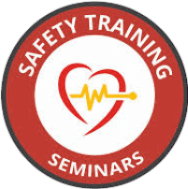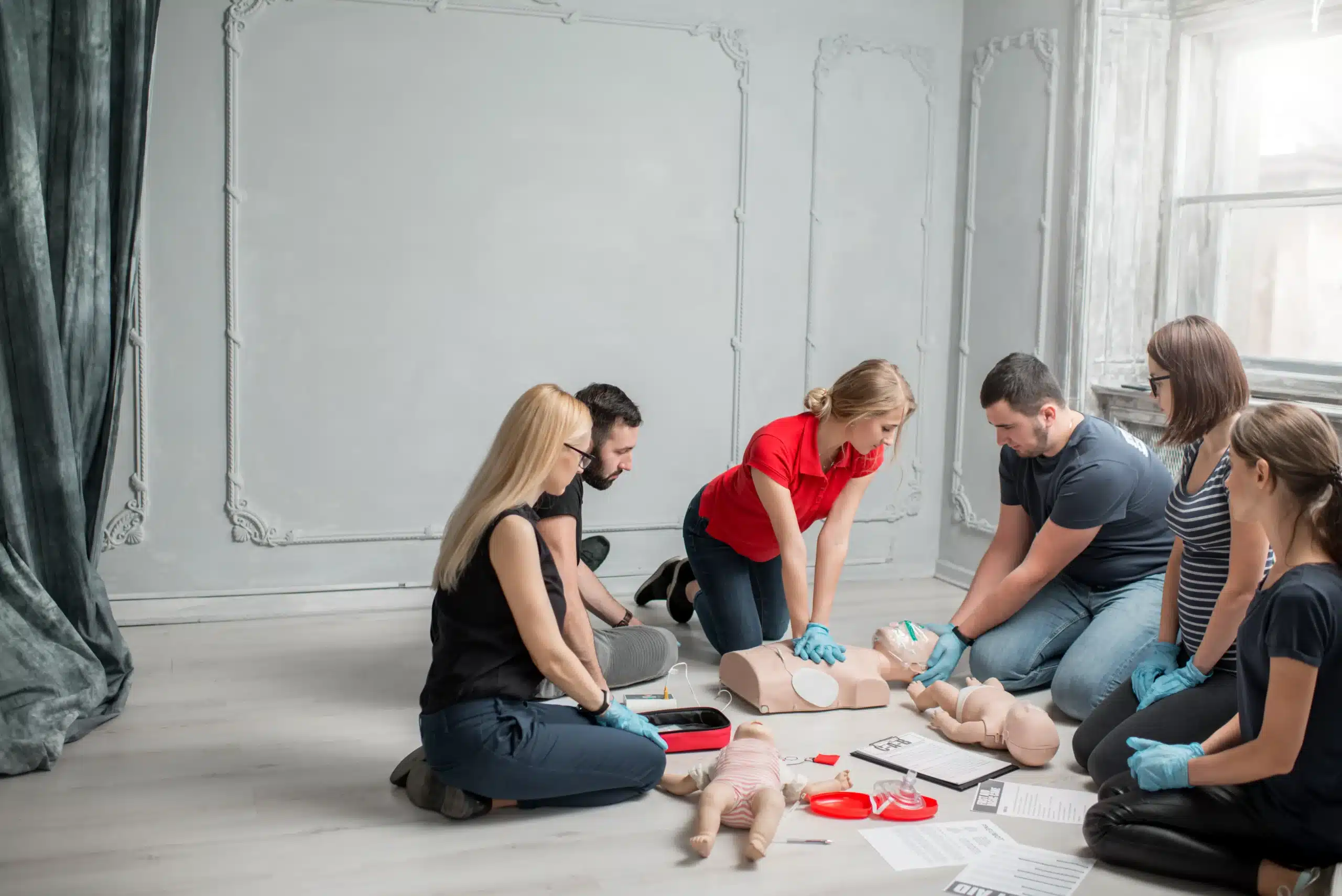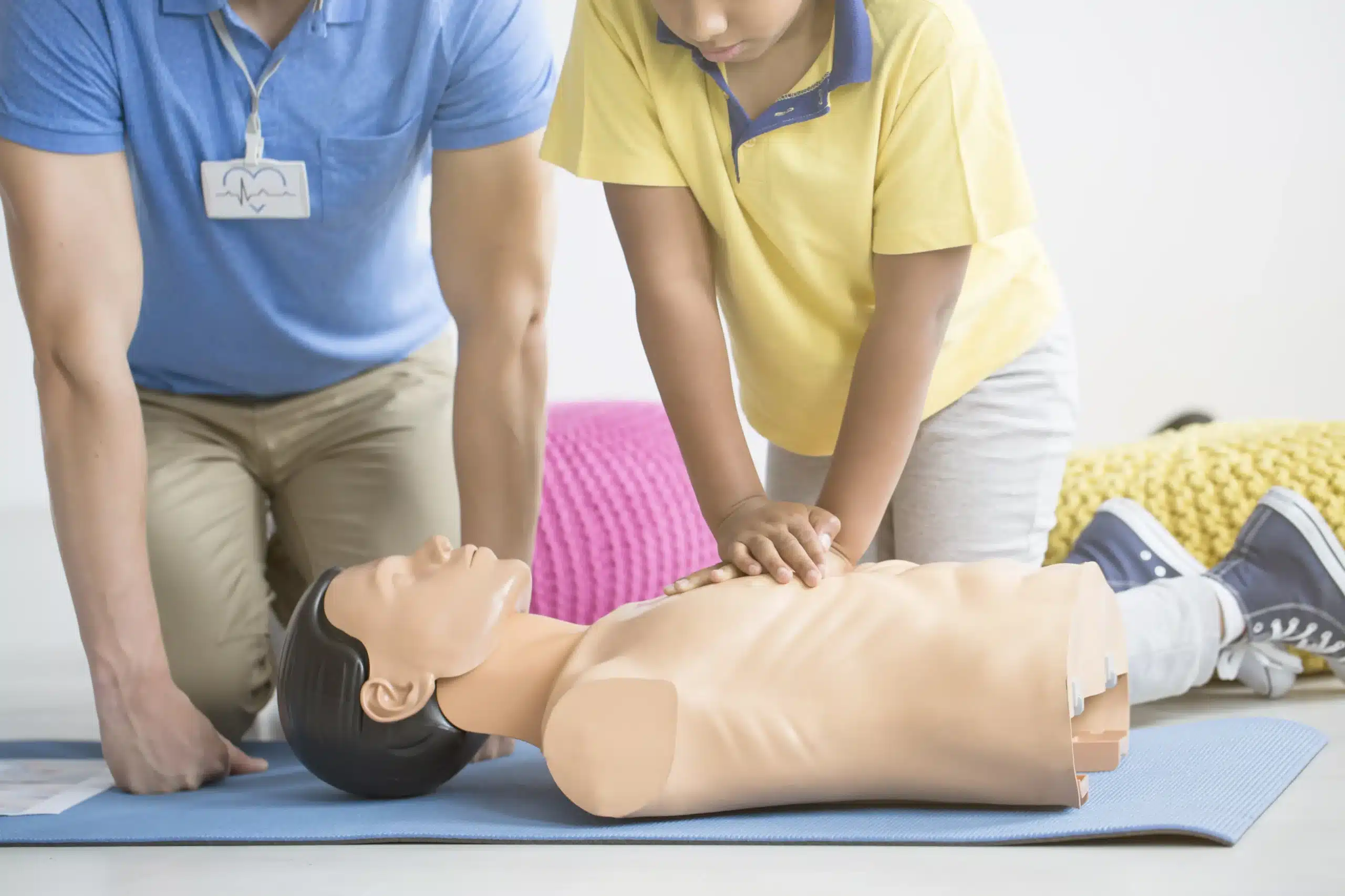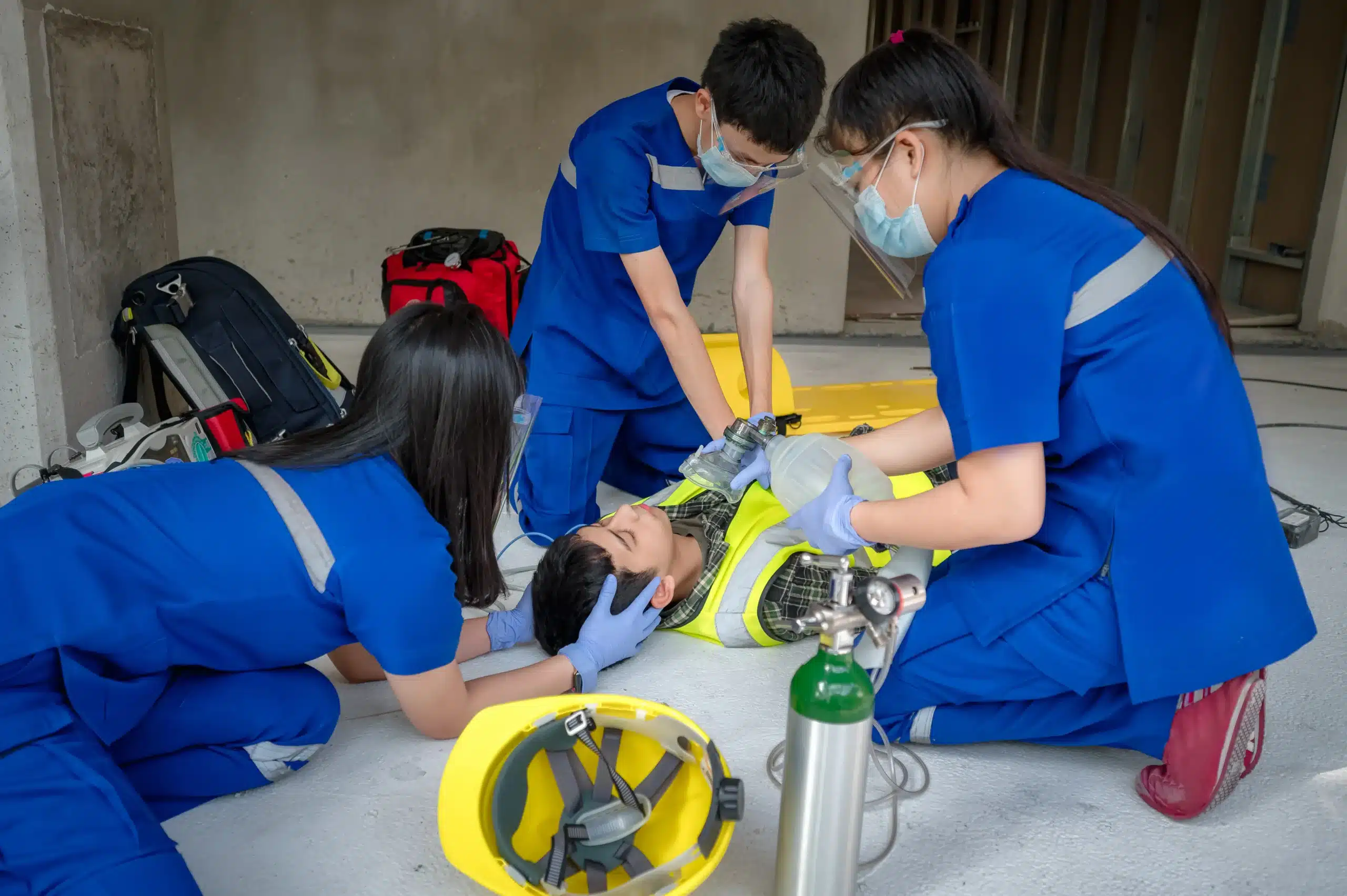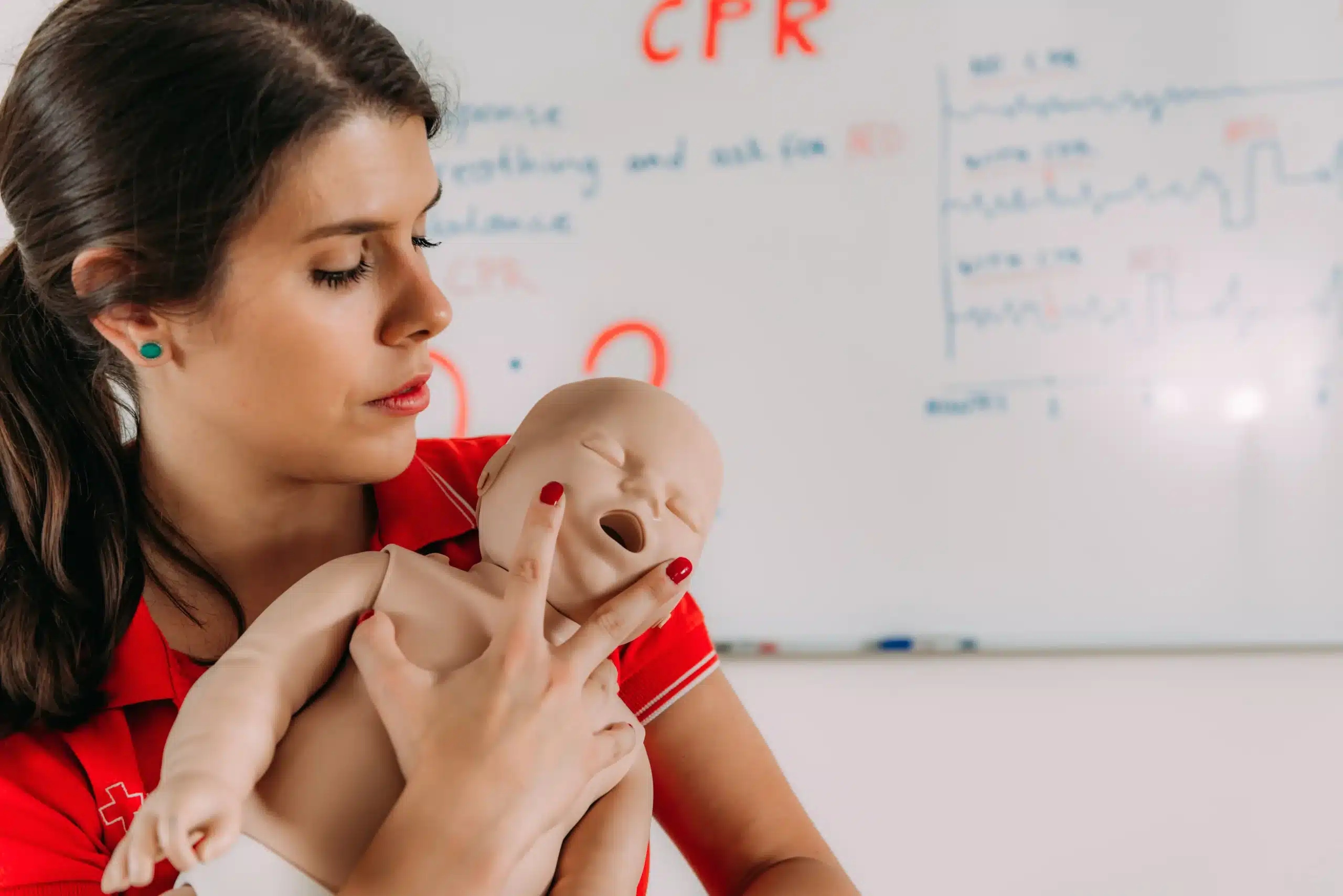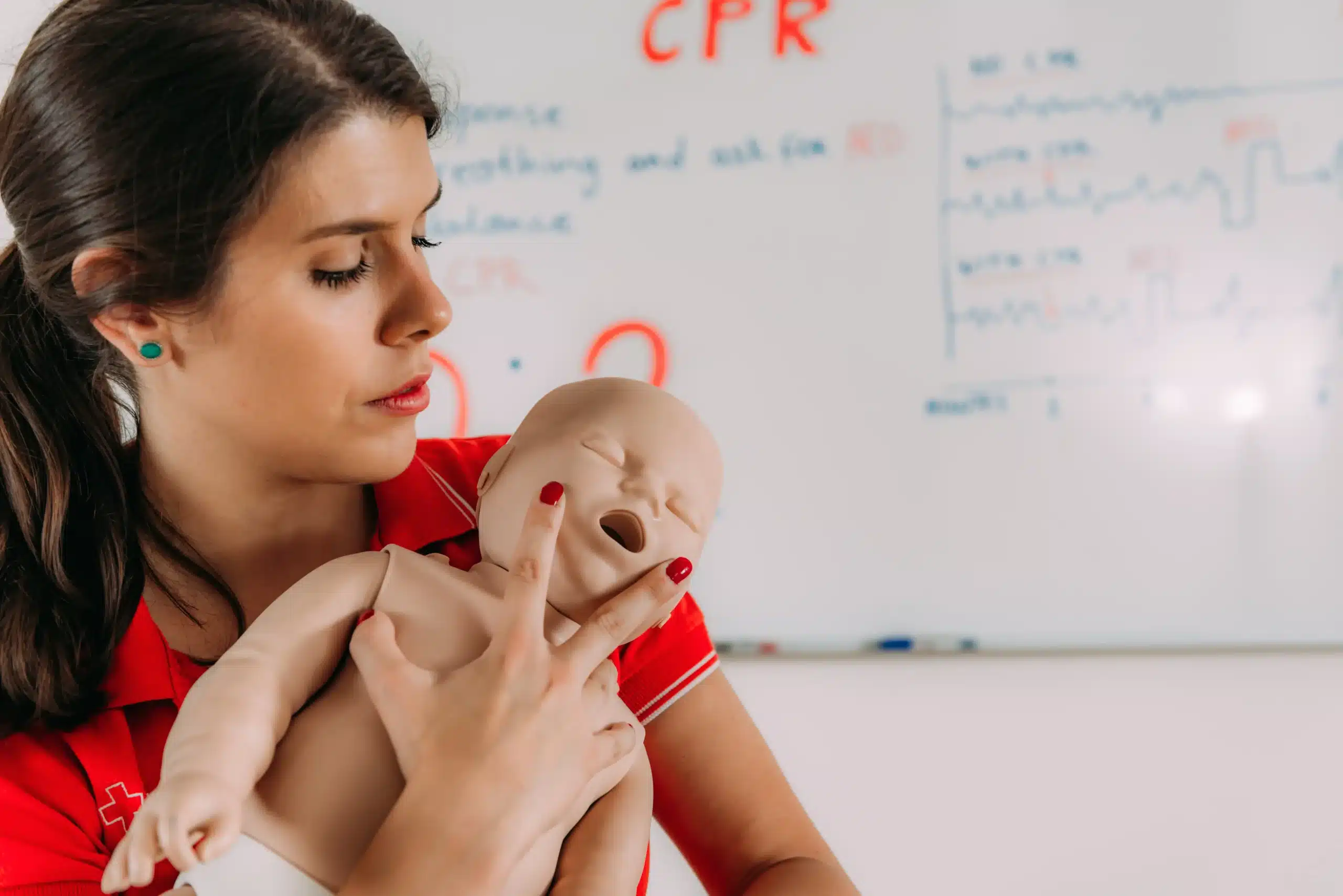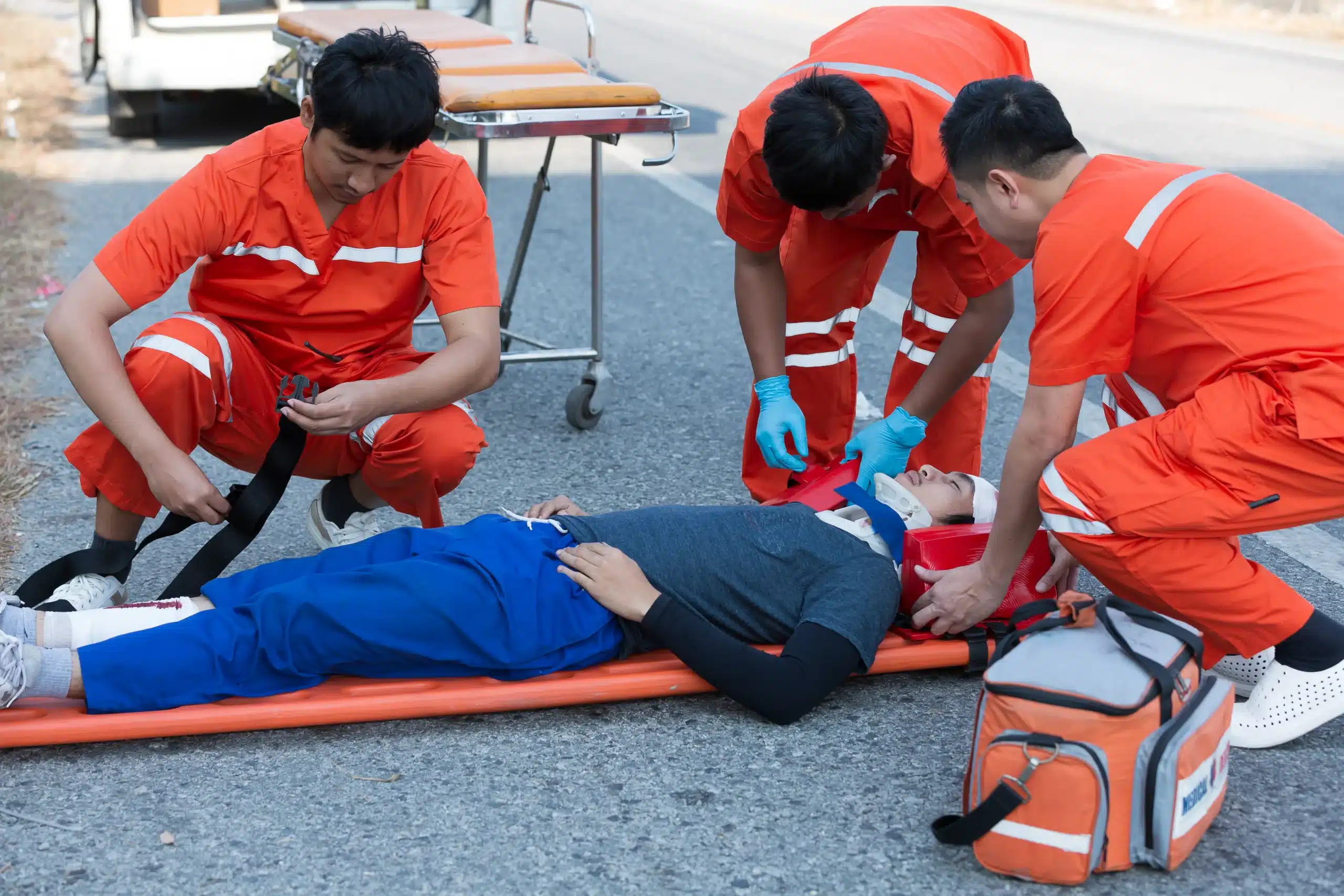Want to make a real difference in your community? Becoming BLS certified is a powerful way to empower yourself with life-saving skills and contribute to a safer environment for everyone. This guide covers everything from the basics of BLS to finding AHA BLS courses nearby. We’ll explore the key components of BLS training, including CPR techniques, AED use, and team dynamics. We’ll also discuss the different learning formats available, the certification process, and how to maintain your BLS certification over time. Plus, we’ll address common misconceptions about BLS and offer tips for choosing the right training provider. Whether you’re a healthcare professional or simply want to be prepared for emergencies, this guide will provide you with the knowledge and resources you need to get started.
Key Takeaways
- BLS equips you with life-saving skills: From CPR and AED use to airway management, BLS training gives you the confidence to act quickly in emergencies. Explore online and in-person options to find a course that works for you.
- Finding a BLS course is easier than you think: Use the AHA website, check local resources, and compare providers like Carmichael CPR Classes to find convenient and affordable training.
- Stay current with your BLS certification: Regular renewal and continuing education ensure you’re always prepared and up-to-date with the latest guidelines. This keeps your skills sharp and demonstrates your commitment to providing high-quality care.
What is BLS?
What does Basic Life Support (BLS) mean?
Basic Life Support (BLS) refers to the level of medical care provided to someone experiencing a life-threatening illness or injury until they can receive full medical care at a hospital. It focuses on maintaining a patient’s airway, breathing, and circulation. BLS teaches CPR (cardiopulmonary resuscitation), how to use an automated external defibrillator (AED), and other emergency techniques for adults, children, and babies. These skills are essential for healthcare providers and anyone who wants to be prepared to help in a medical emergency. For more information, visit the American Heart Association BLS page.
What will you learn in a BLS course?
BLS certification courses cover a range of life-saving techniques. You’ll learn how to perform CPR on adults, children, and infants, including chest compressions and rescue breaths. The training also covers how to use an AED, a portable device that can help restore a normal heart rhythm. You’ll also learn essential skills like airway management and how to recognize the signs of a heart attack or stroke. BLS courses emphasize team communication and dynamics, crucial in emergency situations. For a more detailed look at what’s covered, check out our guide to BLS courses in Carmichael.
Why is BLS important?
BLS is important for several reasons. It equips you with the skills to potentially save a life. Knowing how to respond effectively in a medical emergency can make a critical difference. Early intervention with CPR or other BLS techniques can significantly improve the chances of survival for someone experiencing cardiac arrest. BLS training also increases your confidence in emergency situations, empowering you to take charge and provide assistance until professional help arrives. Finally, BLS certification is often a job requirement for many healthcare professionals and other positions, such as childcare providers and lifeguards. For more information on BLS and CPR certifications, take a look at this helpful resource.
Find BLS Courses Near You
So, you’re ready to get your BLS certification—great! Finding the right course near you doesn’t have to be a headache. Here’s how to find BLS training:
Use the AHA Website
The American Heart Association (AHA) website has a “Find a Class” tool. It’s a simple way to locate BLS courses from certified AHA Training Centers in your area. Enter your zip code or city to see upcoming classes, times, and locations. This tool streamlines your search and ensures you find a legitimate AHA-certified course. Learn more about AHA BLS courses.
Check Local Training Centers and Community Resources
Many hospitals, community colleges, and dedicated training centers offer BLS certification courses. For example, Safety Training Seminars, a woman-owned American Heart Association Training Center, offers BLS, ACLS, PALS, CPR, and First Aid courses in Carmichael. Checking with local resources can often uncover convenient and reputable training options. Plus, you’ll be supporting local businesses. Residents of Carmichael, Rancho Cordova, or Fair Oaks can explore BLS courses in Carmichael.
Explore Online Options
If a traditional classroom doesn’t work for you, online BLS courses are a great alternative. Providers like ACLS Medical Training offer online BLS certification with continuing education credits. These courses offer flexibility, letting you learn at your own pace and on your own schedule. Find more information on finding convenient BLS training.
Use Mobile Apps
While not all organizations have specific apps for finding BLS courses, some, like the AHA, offer resources through their main app. The AHA’s Atlas app provides information on advanced cardiovascular life support, which builds on core BLS skills. Mobile apps can be a handy way to stay updated on courses and resources.
How Much Does BLS Certification Cost?
So you’re ready to get your BLS certification—fantastic! Naturally, one of your first questions might be about the cost. Let’s break down BLS certification costs, explore ways to find affordable options, and discuss why this training is a worthwhile investment.
Certification and Renewal Costs
BLS certification costs vary depending on several factors, including your location, the training provider, and the type of course you choose (initial certification, renewal, or skills session). Generally, you can expect to pay somewhere between $55 and $300 for BLS certification. Some providers, like Carmichael CPR Classes, offer a low price guarantee, so it’s always a good idea to compare prices. Initial BLS certification courses typically fall in the $40–$50 range, while renewal courses are often less expensive. Remember that these prices can fluctuate, so checking with your chosen provider for the most up-to-date pricing is always recommended.
Group Rates and Discounts
Looking to train a whole team or group of colleagues? Many BLS providers offer group discounts, which can significantly lower the cost per person. Be sure to ask your local training center or chosen provider about group rates. If you’re in the Carmichael, Rancho Cordova, or Fair Oaks areas, Carmichael CPR Classes is known for its competitive pricing and commitment to finding a course that fits your budget.
Long-Term Benefits and Career Advancement
While there’s an upfront cost for BLS certification, consider the long-term benefits. This training equips you with essential, potentially life-saving skills, including CPR, AED use, and airway management. These skills empower you to respond confidently in emergencies, whether you’re a healthcare professional or simply want to be prepared for anything. For medical professionals, BLS certification is often a job requirement and can open doors to career advancement. Even outside of healthcare settings, having BLS certification demonstrates your commitment to safety and preparedness, a valuable asset in many workplaces and communities. Think of it as an investment in yourself, your career, and the well-being of those around you.
BLS Training: Format and Duration
In-Person vs. Online
BLS training comes in both in-person and online formats. In-person classes offer hands-on learning and direct interaction with your instructors, allowing for immediate feedback and personalized guidance. Online BLS courses offer flexibility and convenience, letting you learn at your own pace and on your own schedule. Providers like ACLS Medical Training offer online BLS certification with continuing education credits. Think about your learning style and schedule when choosing the best format for you.
Course Structure and Duration
A typical in-person BLS certification course takes around 4.5 hours. This covers essential life-saving skills and the principles behind them. Online courses may vary in length depending on the program and how quickly you learn. Regardless of the format, BLS courses cover the same core content, ensuring comprehensive training.
What to Expect During Training
BLS training prepares you to respond effectively in medical emergencies. The AHA’s BLS course teaches you to quickly recognize life-threatening emergencies, perform high-quality chest compressions, deliver appropriate ventilations, and use an AED. You’ll learn how to assess a situation and perform CPR on adults, children, and infants. The training also emphasizes teamwork and clear communication during emergencies.
Hands-on Practice and Skills Assessment
Hands-on practice is key to BLS training. You’ll practice CPR techniques on mannequins, simulating real-life scenarios. The AHA BLS course teaches both single-rescuer and team BLS skills, focusing on high-quality CPR and team dynamics. This practice builds confidence and muscle memory so you can act quickly and efficiently in a real emergency. Your skills will be assessed throughout the course to ensure you meet the certification standards.
Key Components of BLS Courses
BLS courses cover core life-saving skills and techniques. Here’s what you can expect to learn:
Adult, Child, and Infant CPR
High-quality CPR is the foundation of BLS. You’ll learn how to perform CPR on adults, children, and infants, adjusting your technique for each age group. This includes chest compressions, rescue breaths, and recognizing the signs of cardiac arrest. The American Heart Association stresses the importance of recognizing life-threatening emergencies and giving high-quality chest compressions and ventilations.
AED Use
Using an automated external defibrillator (AED) can dramatically improve survival rates during cardiac arrest. BLS courses will teach you how to use an AED safely and effectively. You’ll learn to assess the situation, prepare the patient, and operate the device. The AHA’s BLS course instruction includes single-rescuer and team BLS skills for both prehospital and in-facility environments.
Choking Relief
BLS training also addresses how to help someone who is choking. You’ll learn techniques to clear the airway of conscious and unconscious individuals. This includes back blows, abdominal thrusts (Heimlich maneuver), and recognizing the signs of a blocked airway. Comprehensive BLS certification provides training in essential life-saving skills, including CPR, AED use, and airway management.
Team Dynamics and Communication
Working effectively as a team is critical in emergencies. BLS courses emphasize clear communication and coordination during resuscitation. You’ll learn how to work together, assign roles, and share information efficiently. The AHA highlights the importance of teamwork and communication in resuscitation.
Prepare for Your BLS Course
So, you’re ready to take a BLS course? Great! This section covers everything you need to know to get ready. We’ll walk you through the prerequisites, required materials, and some tips for a successful learning experience.
Prerequisites and Eligibility
The BLS course is designed for healthcare professionals, like doctors and nurses, and anyone else who needs to know CPR and other basic life support skills. This can include settings like hospitals, clinics, and even pre-hospital environments. The American Heart Association offers a comprehensive BLS Provider Course designed to equip you with these essential skills. No prior experience is typically required, but check with your chosen provider to confirm.
Required Materials
Before your class, make sure you have the right study materials. Most BLS courses use the American Heart Association’s official BLS Provider Manual. Your instructor will let you know if there are any other materials you need to bring. The full BLS Provider Course takes roughly 4.5 hours to complete, including skills practice and testing. Knowing this ahead of time helps you plan your schedule accordingly. You can often purchase the manual directly through your course provider or from the American Heart Association.
Tips for Success
A little preparation goes a long way! Before your BLS course, take some time to familiarize yourself with basic CPR and first aid. This will give you a solid foundation for the material covered in class. Carmichael CPR Classes offers resources to help you find training that fits your schedule and budget. Looking for affordable options? Compare local providers and don’t hesitate to ask about group discounts. You can also explore the benefits of in-person BLS training on Carmichael CPR Classes’ BLS course guide. Consider your learning style too. Some students prefer in-person instruction, while others thrive in online or blended learning environments. Choosing the right format can make a big difference in your overall success.
Maintain Your BLS Certification
Once you’ve earned your BLS certification, staying current is key. This not only ensures you’re prepared to respond to emergencies but also demonstrates your commitment to providing high-quality care. Here’s how to maintain your BLS certification and keep your skills sharp:
Renew Your Certification
BLS certification, like most healthcare certifications, isn’t a one-time deal. You’ll need to renew your certification periodically to stay up-to-date with the latest guidelines and maintain your credentials. The American Heart Association (AHA) offers various renewal options, including online courses and in-person classes. This flexibility lets you choose the method that best suits your schedule and learning style. Check with your employer or certifying organization for specific renewal requirements.
Continuing Education
Continuing education is a valuable way to reinforce your BLS skills and knowledge. Many organizations offer continuing education credits as part of their BLS courses. These courses often cover advanced topics and techniques, allowing you to expand your skillset and stay at the forefront of best practices. Online BLS courses that include continuing education credits are a convenient option for busy professionals.
Stay Updated on Guidelines
Staying informed about the latest AHA guidelines is crucial for effective BLS practice. Guidelines for CPR and Emergency Cardiovascular Care (ECC) are regularly updated to reflect the latest scientific research and best practices. The most current guidelines from the AHA are a great resource. Make sure you’re familiar with current recommendations for chest compressions, ventilations, and AED use. This ensures you’re prepared to respond effectively and confidently in any emergency situation.
Choose the Right BLS Provider
Finding the right Basic Life Support (BLS) class shouldn’t be difficult. Whether you’re a healthcare professional, a student, or just want to be prepared, consider these factors when selecting a BLS provider.
Factors to Consider
Think about what matters most to you in a learning environment. Is it a convenient location? A flexible schedule? Or perhaps a particular teaching style? Some providers offer blended learning with online components, while others focus on traditional classroom settings. Consider also your budget and whether group discounts are available. Carmichael CPR Classes, for example, offers a low price guarantee. Understanding your priorities will help you narrow your options.
Evaluate Instructors
Experienced, certified instructors are crucial for effective BLS training. Look for providers whose instructors have extensive real-world experience and strong teaching skills. The American Heart Association (AHA) BLS course covers essential skills like high-quality chest compressions, delivering ventilations, and the early use of an AED. A skilled instructor can make all the difference in mastering these techniques. Check instructor bios and look for certifications and testimonials.
Read Reviews
Before committing to a BLS course, see what other students have to say. Online reviews can offer valuable insights into the quality of instruction, the course materials, and the overall learning experience. Look for reviews that mention the instructor’s effectiveness, the clarity of the material, and the helpfulness of the staff. You can find reviews and testimonials for Carmichael CPR Classes online to get a sense of their reputation. Reading reviews can give you a clearer picture of what to expect.
Top BLS Course Providers
Several organizations offer high-quality BLS certification courses. Here are a few reputable providers to consider:
Carmichael CPR Classes
Carmichael CPR Classes offers a range of courses, including BLS, ACLS, PALS, CPR, and First Aid. They prioritize accessible training with a focus on excellent customer service. Serving Carmichael, Rancho Cordova, and Fair Oaks, they offer daily classes and a low-price guarantee. If you’re in the area, they are a convenient and affordable option for AHA CPR and First-aid certification.
American Red Cross
The American Red Cross is a well-known provider of BLS for Healthcare Providers courses. Their training meets various certification and licensing requirements, making them a reliable choice for healthcare professionals.
National Safety Council
The National CPR Foundation, affiliated with the National Safety Council, offers online medical certification courses, including BLS. This can be a good option for those who prefer online learning or have scheduling challenges.
ProTrainings
ProTrainings offers a variety of CPR and first aid training courses, including BLS certification. They emphasize convenience and accessibility, with various course formats and schedules available.
HeartCert CPR
HeartCert CPR provides a range of CPR and BLS training options. They focus on providing current and effective training methods to ensure participants receive up-to-date instruction.
Common BLS Misconceptions
It’s easy to get confused about BLS certification, especially with so much information (and misinformation) online. Let’s clear up some common misconceptions.
Online Course Difficulty
One common question is about the difficulty of online BLS courses. While online learning offers flexibility, the American Heart Association (AHA) requires a hands-on skills assessment, regardless of whether you complete the course content online. Beware of any program claiming a fully online BLS certification—it’s simply not a legitimate option through the AHA. The online portion covers the cognitive material, but you’ll still need to demonstrate your skills in person. You can find credible information about this requirement on the AllNurses forum.
Hands-on Skills Assessment
Some people mistakenly believe they can get BLS certified without practical experience. This isn’t true. BLS certification requires demonstrating your skills in person to a certified instructor. The course includes both a written and skills test, and you’ll need to score at least 84% to pass. LeaderStat provides a helpful overview of what’s involved in obtaining BLS certification through the AHA.
BLS vs. CPR Training
It’s important to understand the difference between BLS and basic CPR training. BLS certification is more comprehensive than basic CPR. It goes beyond cardiac emergencies to include a broader range of skills needed by healthcare professionals. BLS also meets specific professional certification requirements, whereas basic CPR might not. The Red Cross website offers a good explanation of what’s covered in a BLS for Healthcare Providers course.
Certification Validity
How long is your BLS certification valid? AHA BLS certification is typically good for two years. The initial course takes about 4.5 hours to complete, including the written and skills tests. Renewal courses are generally shorter, around three hours. LeaderStat’s resource on obtaining AHA BLS certification clarifies these details.
Instructor Quality
Finally, the quality of your instructor matters. The AHA emphasizes the importance of best-in-class instructors who can effectively teach the techniques necessary for proper BLS. Look for training centers and programs that prioritize experienced, certified instructors. The Red Cross highlights the significance of qualified instructors for their BLS courses.
BLS and Community Safety
BLS certification goes beyond personal gain; it strengthens the fabric of our communities. By equipping individuals with essential life-saving skills, we create a network of prepared responders who can make a real difference in times of crisis. Let’s explore how BLS contributes to community safety:
Improve Survival Rates
Early intervention is key to surviving a cardiac emergency. BLS training empowers individuals to recognize life-threatening situations and provide immediate assistance. High-quality chest compressions, ventilation, and early use of an AED can significantly improve survival rates. Learning BLS can mean the difference between life and death for someone experiencing cardiac arrest. The faster someone receives effective CPR and BLS, the greater their chances of recovery. The American Heart Association emphasizes the importance of high-quality CPR and early intervention in improving survival rates.
Build a Culture of Preparedness
BLS training fosters a culture of preparedness within communities. When more people are equipped with life-saving skills, communities are better prepared to respond to emergencies. BLS certification equips individuals with the knowledge and confidence to handle medical emergencies effectively, creating a ripple effect that strengthens community resilience. This sense of preparedness extends beyond individual emergencies, contributing to a safer environment for everyone. Carmichael CPR Classes offers the training you need to become a vital link in your community’s safety net. They are a woman-owned American Heart Association Training Center, committed to providing high-quality instruction.
Empower Lifesavers
BLS certification empowers individuals to become true lifesavers. It provides the skills and confidence to respond effectively in various emergencies, from cardiac arrest to choking incidents. Knowing how to administer CPR and provide basic life support can transform bystanders into confident first responders. This empowerment not only saves lives but also strengthens communities by creating a network of skilled individuals ready to assist in times of need. You can find BLS certification courses near you to develop these essential skills. Finding affordable, high-quality training is easier than you think. Compare local providers like Carmichael CPR Classes to find courses that fit your schedule and budget.
Related Articles
- BLS Certification Near Me: Your Complete Guide – Carmichael CPR Classes
- Find BLS Classes Near Me: Your Complete Guide – Carmichael CPR Classes
- BLS Recertification Near Me: Your Complete Guide – Carmichael CPR Classes
- BLS HeartCode Carmichael: Your Certification Guide – Carmichael CPR Classes
- BLS Renewal Nearby: Your Complete Guide – Carmichael CPR Classes
Frequently Asked Questions
What’s the difference between BLS and CPR certification?
BLS (Basic Life Support) certification is more comprehensive than general CPR training. It includes CPR but also covers a broader range of skills like using an AED and relieving choking, focusing on team dynamics and communication in medical emergencies. It’s designed for healthcare providers and those in roles requiring a higher level of emergency preparedness. CPR training focuses primarily on cardiopulmonary resuscitation techniques.
How long does it take to get BLS certified?
A typical BLS certification course takes about 4.5 hours to complete. This includes instruction, skills practice, and testing. Renewal courses are often shorter, usually around 3 hours. Online BLS courses offer more flexibility, allowing you to complete the cognitive portion at your own pace, but you’ll still need to attend an in-person skills session and assessment.
How much does BLS certification cost?
The cost of BLS certification varies depending on the training provider, location, and course type (initial or renewal). Expect to pay between $55 and $300. Many providers offer group discounts, so inquire about those if you’re training with colleagues. Remember to factor in the cost of the BLS Provider Manual, which is usually required.
Where can I find BLS courses near me?
You can find BLS courses through several avenues. The American Heart Association website has a “Find a Class” tool that locates certified training centers in your area. Local hospitals, community colleges, and dedicated training centers also offer BLS courses. For online options, explore providers like ACLS Medical Training or the National CPR Foundation.
How do I maintain my BLS certification?
BLS certification typically needs renewal every two years. You can renew through online or in-person courses offered by various providers, including the American Heart Association. Staying current with the latest AHA guidelines for CPR and ECC is essential for maintaining your skills and knowledge. Continuing education courses can also help reinforce your expertise and introduce you to advanced techniques.
